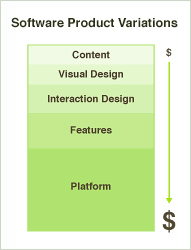October is quickly turning into International Interface Design Month here at Functioning Form. From Chris Palmieri’s Japanese Typography primer to an overview of Steve Portigal’s International Ethnographic Research talk, we’ve been seeing many of the globalization issues that design teams face when their products cross borders. Knowing where international variations might exist, however, is only half the battle. The other half is deciding what to do about it.
Companies with international product rollout strategies often face a basic dilemma: how much localization is enough? Each product variation added to accommodate local market conditions (or cultural differences) costs money and adds complexity (added development and design time). Conversely, international variations may be vital for product success in a different market (especially when there’s a need to accommodate local infrastructure or differences in consumer behavior). Finding the right balance between potential revenue and costs produced by international product variations is not an easy task.
 First of all, variations within a software product can exist at multiple levels: content (text and images), visual design (skins and branding elements), interaction design (interface elements and flows), features (available or modified), and platform (back-end data structures, business logic, and more). Potentially, the least expensive level to localize is the product’s content and the most expensive is a significant platform change. But the right solution may touch a number of layers: interface elements to accommodate local infrastructure (address input fields), visual changes to match local tastes (color associations), unique features (local government requirements), etc.
First of all, variations within a software product can exist at multiple levels: content (text and images), visual design (skins and branding elements), interaction design (interface elements and flows), features (available or modified), and platform (back-end data structures, business logic, and more). Potentially, the least expensive level to localize is the product’s content and the most expensive is a significant platform change. But the right solution may touch a number of layers: interface elements to accommodate local infrastructure (address input fields), visual changes to match local tastes (color associations), unique features (local government requirements), etc.
Second, it’s not easy to measure the potential impact on revenue that cultural variations might have. Usually, companies find out that something’s not working only after a localized product launches, and by then it may be too late.